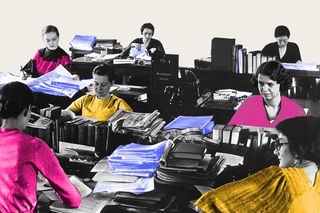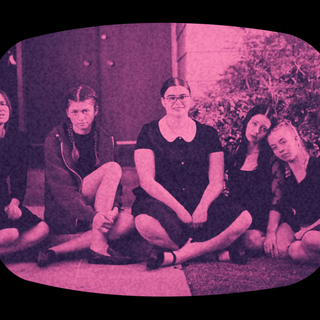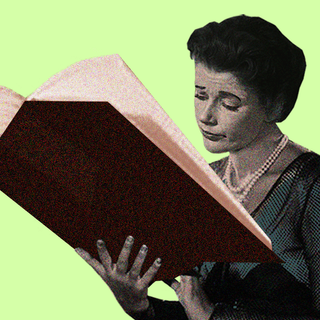
How Fact‑Checking in News Started Out as a Woman’s Job
At a time when misinformation reigns supreme, the cultural history of fact-checking shows who was instrumental in shaping the truth in news.

In 1943, the TIME magazine’s co-founder Henry Luce roaringly said these words in a speech: “Little did we realize that in our private jest we were inaugurating a modern female priesthood — the veritable vestal virgins whom levitous writers cajole in vain, and managing editors learn humbly to appease.”
Luce was speaking of the cohort of “researchers,” a title that was held by only women in the organization until 1973. Some pointed derision sticks out from his speech — modern womenof the ’40s, who are pure virgins, haranguing writers and editors about facts and accuracy.
Oh, women and their “fussing.”
Gender has been the axis of many ideological conflicts in the workplace — the wage gap, the way work is perceived, the kind of appraisals people get. Gender bias trickles down to the rungs in minute ways. The same persists in the world of news reporting and media. But turns out, the cultural history of media fact-checking is inextricably tied to gender norms too. It not only raises important questions about how women are perceived in the workplace, but also what cultural value we bestow upon truth-telling — especially at a time when hypermasculinepolitical leaders insist upon rewriting history and upholding misinformation as the truth.
At its core, industry alumni refer to a gender binary that was at the heart of the media hierarchy. The reporter/writer/editor — usually male — worked with female “researchers” who were tasked with objecting to claims and facts in news pieces. Briton Hadden, the co-founder of TIME, went as far as to say the tense relationship between the reporter-researcher mirrored the natural competition between the sexes. Much like now, the researcher would gather extra research material for an article and then work to verify every fact. In some organizations, researchers were almost always women, which some were quick to term as a “free rein” for empowered women. “But that the free rein wasn’t necessarily about empowering the women: it also fell into the old trope of a woman haranguing a put-upon man,” wrote Merrill Fabry.
Related on The Swaddle:
In a First, Twitter Flags President Trump’s Tweet as Misleading
When seen in this context, some anecdotes show how researchers’ objections to some facts were perceived as them creating an “unnecessary fuss.” Nancy Ford, the first researcher at TIME who started in 1923, was often perceived as the organization’s “first Girl Friday.” She soon quit her job. The researchers were called “girls” almost as a rule. “Anything that couldn’t be verified meant querying the author to hammer out the way a sentence should read, though later official guidelines mandated a demure or ladylike tone when doing so,” wrote Fabry in another article detailing the history of fact-checking in the 1920s.
In one 1944 pamphlet written especially for researchers (all women), the commandments made sexism bare: researchers should be “intelligent (but not blue stocking), charming (but not giddy)…neither aggressive nor suppliant.” The unnamed writer of this pamphlet, instructing journalists at TIME, said a “researcher should never forget what a nuisance she can be merely because she is a woman…The researcher must prove, by her unspectacular behavior, that she is no more trouble than a man would have been.”
The gendered expectations that have loyally stuck through history also played a role in how the work of fact-checking was perceived. Research and probing a claim’s accuracy was seen as supplementary to a “hard-core,” ideologically intensive labor. Sample this prickly poem, titled “It’s a Fact,” written in the 1920s by a magazine editor: “For facts of this, for facts of that, / They spend their days in squawk and strife, / But they are not so expert at / Determining the Facts of Life.” “They” here unmistakenly refers to the score of female fact-checkers that was coming up in news organizations. But they were often deemed to only carry “bookish knowledge” and naive in other realities of the world.
These researchers also doubled as “the girls” who would be tasked with office housekeeping, like writing memos or distributing lists. Even now, it is almost always women who are tasked with “office housework”; the onus of performing “domestic” functions conveniently falls on women who are expected to be “naturally talented” at these chores. An article in The New York Times notes that “in keeping with deeply held gender stereotypes, we expect men to be ambitious and results-oriented, and women to be nurturing and communal.” The same stereotype tied the relationship between a researcher and writer too. Another one of these poems goes: “If substance fails, if fact eludes, / Out of the air he picks it— / If obviously foolish, why / The girls will probably fix it.”
Research and fact-checking then become a job role that was intertwined with the idea of gender. The relationship, didactic guidance, and perception offer a window into how women — and accuracy — were systemically devalued.
Related on The Swaddle:
News Panels Moderated by Men Are Far More Hostile Than Women‑Led Panels, Finds Report
The past and the present are rife with examples of how the gender of a worker shapes the way the work is valued. Think of the sexism women continue to face in STEM fields. Soon after changing dynamics in the media industry elevated women to reporting and editing roles (women filed lawsuits against this evident sex segregation in jobs), fact-checking “became less marked as a woman’s job,” Fabry pointed out. Today, there are almost 149 fact-checking organizations globally.
The fight against misinformation tells us that truth is not always black and white. That seems to be the foundation of a feminist fact-check media organization: “We’re not just going to track false news, but also try to have a more nuanced approach to finding stuff like manipulated presentation of facts: misinformation that’s not false, but skewed,” said research coordinator Tijana Cvjetićanin. “It has something that — I wouldn’t call it bias — but a certain standpoint where it starts from, which is that women and men are equal and you should not work against that premise.”
Fact-checking is a serious endeavor — one that’s become a moral and professional necessity in our dizzying realities. How we tell the truth, or the importance we place upon its tired shoulders, depends entirely on how we perceive the purpose of fact-checking. If the process in itself is thought to be “nitpicking,” something women do to harangue people in power, it loses its power. It creates a vicious world where autocrats create a context to invade countries, rulers gaslight their citizens and abdicate responsibility, deliberately misrepresent facts — and no one raises a finger.
It then becomes imperative to look at the cultural shifts happening in tandem with the rise of fact-checking in media organizations.The gendered legacy of fact-checking tells us a lot about the state of news today where facts are once again perceived as immaterial in the grand scheme of things. That it was considered “women’s work” may help us understand its devaluation better and, in turn, fight it more equitably.
Saumya Kalia is an Associate Editor at The Swaddle. Her journalism and writing explore issues of social justice, digital sub-cultures, media ecosystem, literature, and memory as they cut across socio-cultural periods. You can reach her at @Saumya_Kalia.
Related


The Season 2 Finale of ‘Euphoria’ Is a Tale of Innocence Lost
